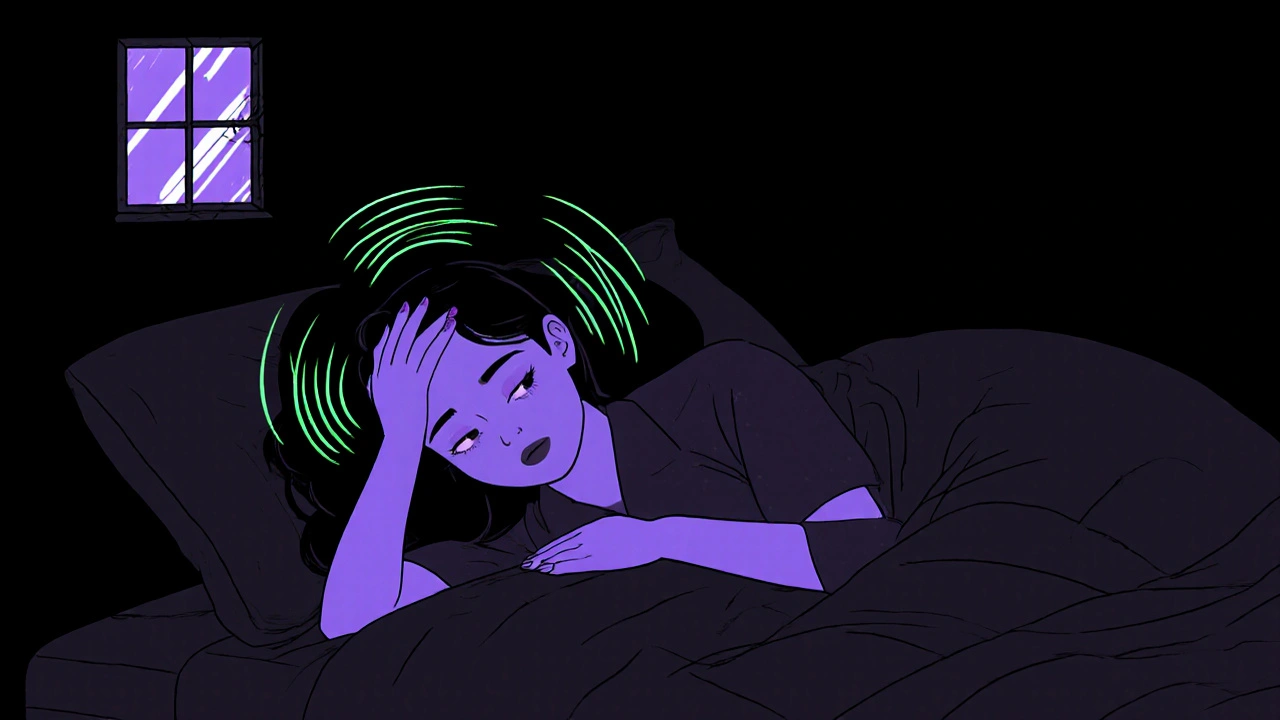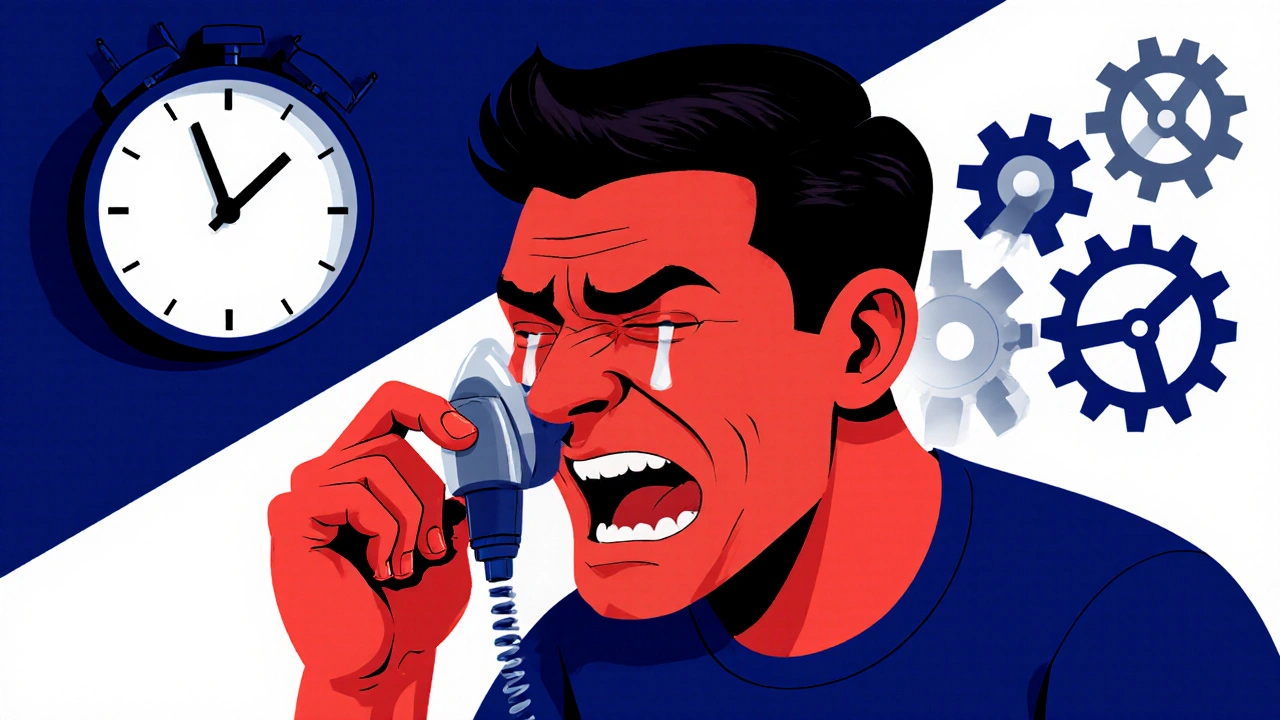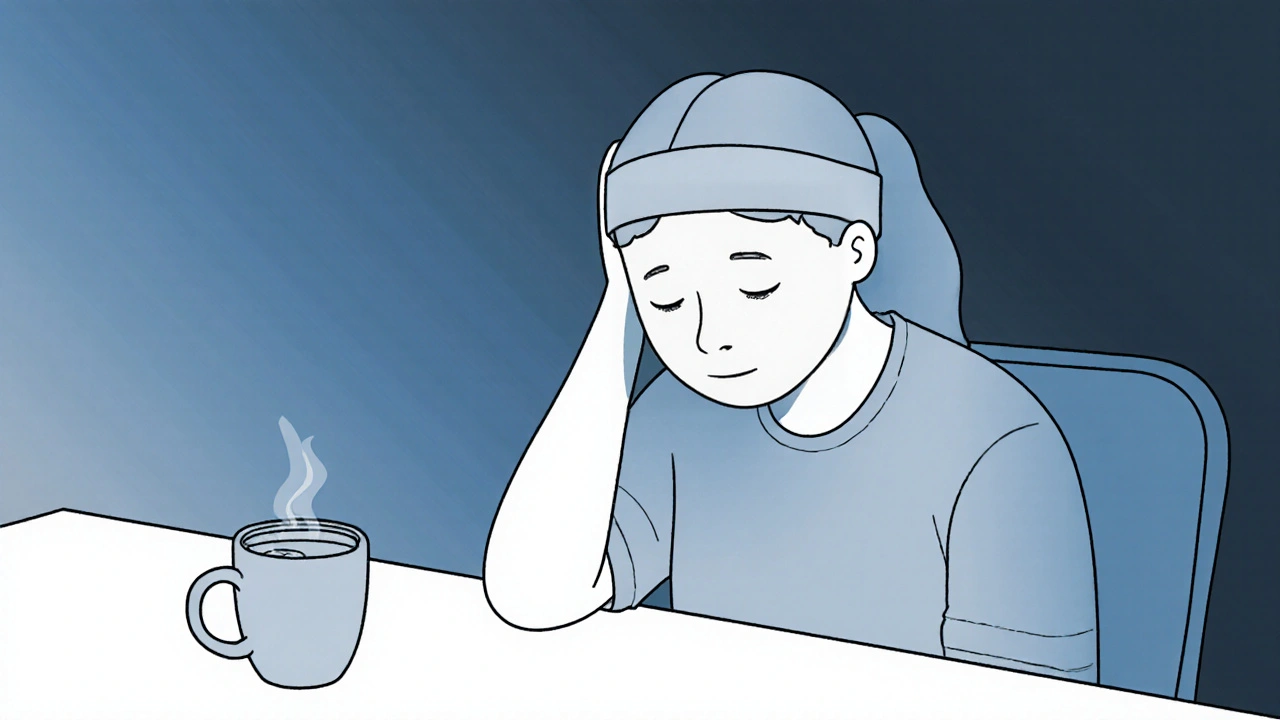Not all headaches are the same. If you’ve ever been told, "It’s just a tension headache," only to end up curled up in a dark room for hours, you know that’s not true. Or maybe you’ve had a pounding pain on one side of your head, with your eye watering and nose running, and the ER doctor called it a migraine-when it was actually something far more intense. The truth is, tension headache, migraine, and cluster headache are three completely different conditions, each with its own cause, pattern, and treatment. Getting the right diagnosis isn’t just about naming the pain-it’s about stopping it effectively.
What a Tension Headache Really Feels Like
Tension-type headaches are the most common kind. About 42% of people worldwide get them at some point. You’ve probably had one: a dull, constant ache that wraps around your head like a tight band. It’s not sharp. It doesn’t throb. It just… stays. You feel pressure on your forehead, temples, or the back of your head. Sometimes it’s mild. Sometimes it’s bad enough to make you want to cancel plans-but it rarely knocks you out of bed. According to the International Classification of Headache Disorders (ICHD-3), these headaches last anywhere from 30 minutes to seven days. If they happen 15 or more days a month for three months straight, they’re called chronic. Women are about 1.4 times more likely to get them than men. And unlike migraines, physical activity doesn’t make it worse. You can walk, work, or cook without the pain getting worse. The pain comes from muscle tension in the neck and scalp, but it’s not just about stress. Your brain’s pain control system gets stuck in overdrive. That’s why OTC painkillers like ibuprofen or acetaminophen work for about 70% of people. No need for fancy meds. No need for emergency visits. Just a nap, a stretch, or a warm shower often helps.Migraines: More Than Just a Bad Headache
Migraines aren’t just headaches. They’re neurological events. About 1 in 5 women and 1 in 10 men get them. The pain is usually one-sided, throbbing, and moderate to severe. But here’s what sets it apart: the other symptoms. Nausea? Almost always-90% of migraine attacks include it. Light sensitivity? 80%. Sound sensitivity? Same. You don’t just want quiet-you need total darkness. You can’t read. You can’t watch TV. You can’t even talk without it feeling like your skull is splitting open. About a third of migraine sufferers also get an aura. That’s a warning sign that comes 5 to 60 minutes before the pain starts. It might be flashing lights, blind spots, or zigzag lines in your vision. Some people feel tingling in their hands or face. Others have trouble speaking. These aren’t hallucinations-they’re real neurological disturbances caused by a wave of electrical activity moving across the brain called cortical spreading depression. Migraine attacks last 4 to 72 hours if untreated. That’s not a few hours. That’s half a day, a full day, or even three days of being completely disabled. The global cost of migraines? Over $36 billion a year in the U.S. alone, from missed work, doctor visits, and lost productivity. Treatment isn’t just about popping pills. Triptans (like sumatriptan) or newer drugs called CGRP inhibitors (like atogepant) work for about half to 70% of people. But they don’t work for everyone. And if you’re using OTC meds more than 10 days a month, you risk turning episodic migraines into chronic ones.Cluster Headaches: The Worst Pain Known to Humans
Cluster headaches are rare-only 1 in 1,000 people get them. But if you’ve had one, you’ll never forget it. This isn’t just pain. It’s torture. The pain is excruciating-rated 8 to 10 out of 10. It’s focused around one eye or temple, and it hits like a drill. Attacks last 15 to 180 minutes, but they come in waves. During a cluster period-which can last 6 to 12 weeks-you might get 1 to 8 attacks a day, always at the same time. Many people wake up 2 to 3 hours after falling asleep with the same piercing pain. And then there are the accompanying symptoms. On the same side as the pain: your eye waters, your nose runs, your eyelid droops, your face flushes. You can’t sit still. You pace. You rock. You scream. People describe it as worse than childbirth, broken bones, or even kidney stones. Cluster headaches are triggered by the hypothalamus-a tiny part of the brain that controls your biological clock. That’s why they often happen at the same time every day, and why many people have seasonal patterns. One in four gets them during spring or fall. Treatment is urgent. High-flow oxygen through a mask is the fastest fix-70 to 80% of people get relief within 15 minutes. Subcutaneous sumatriptan works too, with 75% effectiveness. But you can’t just take a pill. You need the right tools, the right timing, and often, a specialist.
How to Tell Them Apart
Here’s the quick cheat sheet:- Tension headache: Both sides of the head, pressure-like, no nausea or light sensitivity, lasts minutes to days, responds to OTC meds.
- Migraine: Usually one side, throbbing, nausea + light/sound sensitivity, lasts 4-72 hours, aura possible, needs specific meds.
- Cluster headache: One side, piercing pain, lasts 15-180 minutes, comes in waves, eye watering and nasal stuffiness, needs oxygen or injection.
Why Diagnosis Matters
Misdiagnosis happens in up to 50% of cases. Why? Because most doctors get only 4 hours of headache training in medical school. A tension headache gets labeled as a migraine. A cluster headache gets called a sinus infection. A migraine with aura gets mistaken for a stroke. That’s dangerous. Taking a triptan for a cluster headache? Might not help. Taking oxygen for a tension headache? Waste of time. Using daily painkillers for a migraine? Could make it worse. The best tool you have? A headache diary. Write down:- When it started and ended
- Where the pain was
- How bad it was (0-10 scale)
- What you felt besides pain (nausea? light sensitivity? eye watering?)
- What you did to treat it
- Any possible triggers (sleep loss, alcohol, stress, weather)

What to Do Next
If you’ve been living with headaches for months or years, don’t just accept it. You deserve relief. - If OTC meds work most of the time and you don’t have nausea or light sensitivity-you likely have tension headaches. Focus on stress management, posture, and sleep. - If you’re incapacitated for hours or days, need darkness, and feel sick-you probably have migraines. Talk to a neurologist about triptans or CGRP inhibitors. - If you have short, brutal attacks with eye watering and nose stuffiness, happening at the same time every day-you could have cluster headaches. See a headache specialist immediately. Oxygen therapy can change your life. The good news? Treatments are getting better. In 2023, the FDA approved atogepant for cluster headache prevention-the first oral drug made specifically for this. Deep brain stimulation and non-invasive nerve devices are showing promise in trials. You’re not stuck with this pain.What to Avoid
Don’t self-diagnose based on internet searches. Don’t assume your headache is "just stress." Don’t wait until you’re in the ER to ask for help. And don’t let anyone tell you it’s "all in your head." These are real, measurable neurological conditions. If you’re getting headaches more than once a week, or if they’re getting worse, it’s time to see a specialist. Neurologists who focus on headaches exist. They’re not easy to find, but they’re out there. Ask your primary doctor for a referral. Or search for an accredited headache center. Your pain is valid. Your experience matters. And with the right diagnosis, you don’t have to live like this anymore.Can a tension headache turn into a migraine?
No, tension headaches and migraines are separate conditions with different causes. But having frequent tension headaches can make your brain more sensitive to pain, which may lower your threshold for triggering a migraine. It’s not a transformation-it’s an increased risk.
Why do cluster headaches happen at the same time every day?
Cluster headaches are tied to your body’s internal clock, controlled by the hypothalamus. This part of the brain regulates sleep, hormones, and circadian rhythms. That’s why attacks often occur at the same time-like 2 a.m. or 9 p.m.-and why they follow seasonal patterns, like spring or fall.
Is there a cure for cluster headaches?
There’s no permanent cure, but many people go into long-term remission. Treatments like oxygen therapy, injectable sumatriptan, and preventive meds like verapamil or atogepant can stop attacks during a cluster period. For chronic cases, deep brain stimulation is showing promising results in clinical trials.
Can stress cause cluster headaches?
Stress doesn’t cause cluster headaches, but it can trigger attacks during an active cluster period. The root cause is neurological-specifically, abnormal activity in the hypothalamus. Alcohol is a more reliable trigger than stress. Avoiding alcohol during a cluster cycle is critical.
Are migraines genetic?
Yes. If one parent has migraines, you have a 50% chance of getting them. If both parents have them, your risk jumps to 75%. Specific genes affecting brain excitability and pain processing are involved. This is why migraines often run in families.
Can children get cluster headaches?
Very rarely. Cluster headaches typically start between ages 20 and 50. Children can get migraines and tension headaches, but cluster headaches in kids are so uncommon that they’re often misdiagnosed as ear infections or sinusitis. If a child has recurring, severe one-sided headaches with eye symptoms, a pediatric neurologist should evaluate them.



Florian Moser
November 22, 2025 at 07:03Finally, someone broke this down without jargon. I’ve had tension headaches for years and thought I was just "stressed out." Learning that it’s a neurological pattern, not just bad posture, changed everything for me. Started stretching my neck daily and using ibuprofen only when needed-no more daily pills. My boss even noticed I’m not rubbing my temples all day anymore.
jim cerqua
November 24, 2025 at 01:13CLUSTER HEADACHES AREN’T JUST PAIN-THEY’RE A CRIME AGAINST HUMANITY. I’ve had them for 11 years. One time I screamed so loud my dog ran out of the house. My wife had to hold me down because I was banging my head against the wall. Oxygen saved my life. But guess what? The VA won’t cover the mask because it’s "not FDA-approved for home use." So I pay $800 a month out of pocket. Welcome to America, folks.
Donald Frantz
November 24, 2025 at 21:29Let’s be real-this article is mostly accurate, but it ignores the elephant in the room: pharmaceutical companies profit from keeping people misdiagnosed. Triptans cost $300 a pill. Oxygen masks? $50. Why isn’t oxygen pushed as first-line treatment everywhere? Because it can’t be patented. Same with magnesium, riboflavin, and feverfew. The medical system thrives on expensive, branded solutions, not cheap, effective ones.
And don’t get me started on how migraine trials are funded by drug makers who then market the drugs to doctors who get kickbacks. This isn’t science-it’s a business model.
Sammy Williams
November 26, 2025 at 14:04Man, I wish I’d read this five years ago. I used to take 3 Advil every day just to function. Thought I was just "a headache person." Turned out I had chronic tension headaches from sitting at my desk with my shoulders up to my ears. Physical therapy and a standing desk fixed 80% of it. Also, hydration helps more than people admit. Just saying.
Julia Strothers
November 27, 2025 at 12:42Who wrote this? Big Pharma’s PR team? They left out the part where the WHO admits that 70% of migraine cases are triggered by EMFs from cell phones and Wi-Fi routers. And cluster headaches? That’s the government’s secret weapon to control sleep cycles. They’ve been using the hypothalamus manipulation since the 90s. That’s why they spike in spring-because the sun’s angle activates the signal. They don’t want you to know this. They want you dependent on oxygen tanks and $10,000 injections.
Erika Sta. Maria
November 27, 2025 at 17:02Actually, I think all headaches are just karma from past lives. I read in a Tibetan text that pain is the soul’s way of saying "you didn’t meditate enough." Also, I had a migraine once after eating pizza in 2017 and now I’m convinced gluten is a CIA mind-control agent. Also, why do doctors always ignore the moon phases? My cousin in Delhi says her cluster attacks sync with full moons. Coincidence? I think not.
Also, I don’t believe in "neurological"-it’s just a fancy word for "we don’t know what’s happening."
Nikhil Purohit
November 29, 2025 at 16:00Great breakdown. I’m a neurology resident in Bangalore, and this is exactly what we teach in our headache clinic. The biggest issue here is access. Most people in rural India can’t afford triptans or oxygen therapy. We use simple things like riboflavin, butterbur, and acupuncture-some work better than drugs. Also, stress management is huge. Many patients think it’s "nerves," but it’s actually sleep deprivation from working two jobs. We need more community health workers trained in headache triage.
And yes-headache diaries are gold. One patient tracked her attacks for 6 months and realized they only happened after eating her mother’s curry. Turned out it was MSG. Simple fix. No pills needed.
Debanjan Banerjee
December 1, 2025 at 08:54Julia’s comment above is pure nonsense, but I get why people believe it. Misinformation spreads faster than facts because it’s emotional. But let’s not throw the baby out with the bathwater. The science here is solid. Cluster headaches are hypothalamic. Migraines involve cortical spreading depression. Tension headaches are myofascial. These aren’t theories-they’re proven with fMRI, EEG, and clinical trials.
That said, I agree with Donald: the pharma industry is complicit. But that doesn’t make the diagnosis wrong. It just means we need better policy, not more conspiracy. If oxygen therapy is effective and cheap, why isn’t it covered by insurance? That’s the real problem.
Also, for anyone reading this: if you’re having more than 8 headache days a month, see a specialist. Not your GP. Not the ER. A headache neurologist. They exist. Find one.
Steve Harris
December 2, 2025 at 14:54Thank you for this. I’ve been living with migraines since I was 16. I’ve seen 7 doctors, been misdiagnosed with sinusitis twice, and spent $12,000 on ineffective treatments before finding a specialist who actually listened. The headache diary changed my life. I now know my triggers: red wine, lack of sleep, and sudden weather drops. I avoid them. I take my CGRP inhibitor religiously. I’m not cured-but I’m functional. And that’s more than I ever thought possible.
To anyone reading this: don’t give up. Your pain is real. You’re not weak. You’re not imagining it. There is help. It just takes patience.
Michael Marrale
December 3, 2025 at 11:08Wait, so you’re telling me the government isn’t using 5G to trigger our headaches? I thought I was special. My neighbor says his smart fridge is making his migraines worse. I’ve been keeping a log of when my fridge turns on. Coincidence? I think not. Also, I think my headaches are caused by aliens harvesting my brainwaves. They only come at 3 a.m. when the moon is in Scorpio. I’ve tried grounding mats, but they didn’t work. Maybe I need a Faraday cage around my bed?
David vaughan
December 3, 2025 at 16:33I’ve had cluster headaches for 8 years. Oxygen saved me. But I’m terrified to go off it. What if it stops working? What if I get another cycle? I keep 3 masks at home, one in my car, one at work. I’ve memorized the oxygen tank serial numbers. I track my sleep like a prison inmate. I don’t drink. I don’t travel. I don’t even hug people anymore-too risky. I’m not living. I’m surviving. And no one understands.
David Cusack
December 3, 2025 at 20:23While the article presents a superficially coherent taxonomy, one must interrogate the epistemological foundations of the ICHD-3 framework-its reliance on subjective self-reporting, its neglect of neurochemical variance across ethnic populations, and its implicit Cartesian dualism that divorces pain from phenomenological context. One wonders, for instance, whether the Western biomedical paradigm’s obsession with localization obscures the transpersonal dimensions of cephalalgia-particularly in cultures where headache is understood as a spiritual resonance rather than a neurological event.
Furthermore, the commodification of triptans as a panacea betrays a profound ontological reductionism. One is left to ponder: is pain merely a biological malfunction-or is it the soul’s lament against the mechanistic tyranny of modernity?
Elaina Cronin
December 5, 2025 at 03:56As a physician who has spent 22 years treating headache disorders in tertiary care, I find this article to be exceptionally well-researched and clinically accurate. The distinction between migraine and cluster headache is not merely academic-it is life-altering. I have seen patients misdiagnosed for over a decade, prescribed inappropriate medications, and subjected to unnecessary imaging-all because of a systemic lack of headache education. The call for headache diaries is not just prudent; it is essential. I urge every clinician to require one. And to every patient reading this: your suffering is valid. You are not alone. And you deserve better than a 10-minute ER visit.
Willie Doherty
December 6, 2025 at 22:27It is curious that the article fails to mention the role of circadian disruption in the pathogenesis of cluster headache. The hypothalamic involvement is well-documented, yet the link to modern sleep hygiene-blue light exposure, shift work, and artificial lighting-is conspicuously absent. One must consider whether the rising incidence of cluster headaches in urban populations is not merely coincidental with the global proliferation of LED lighting and sleep-deprived lifestyles. The data is there. The correlation is clear. The medical community, however, remains willfully blind.